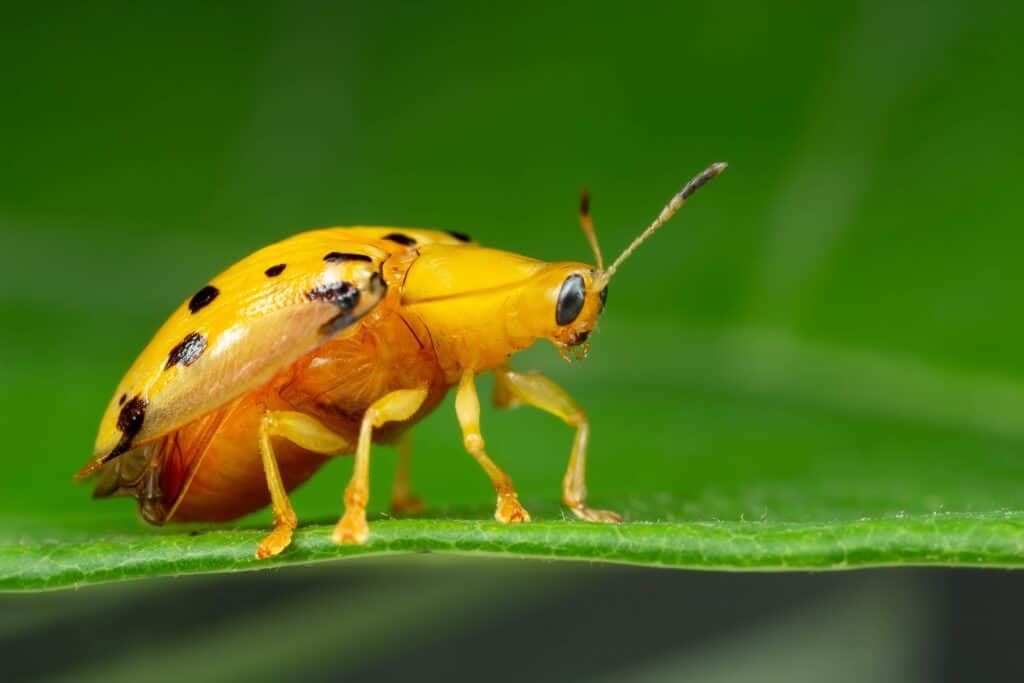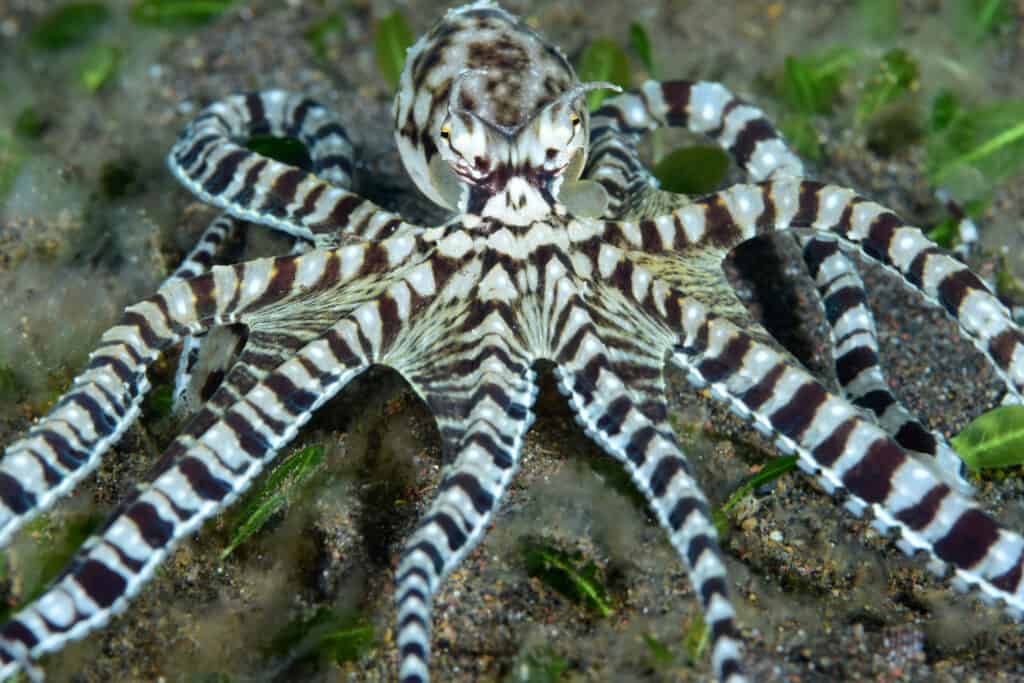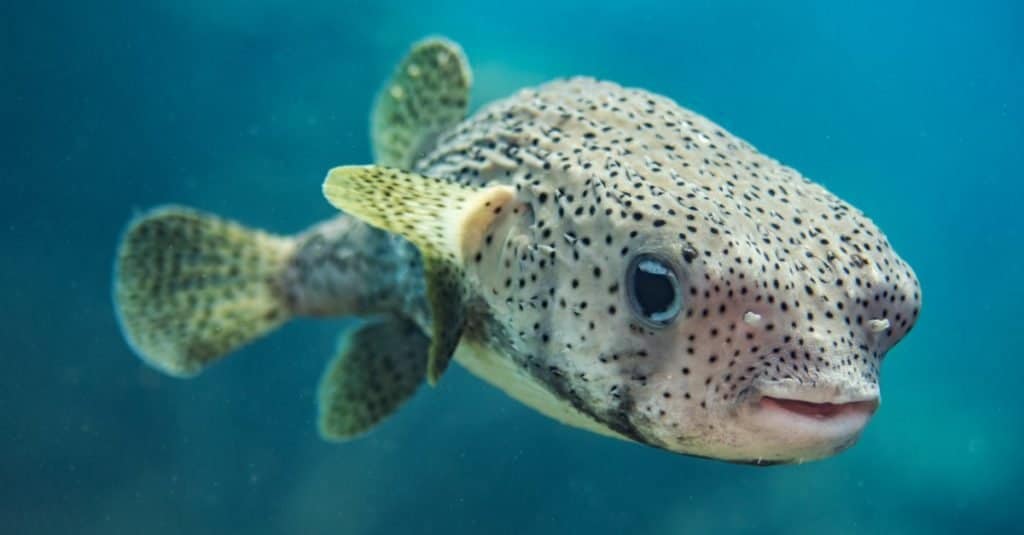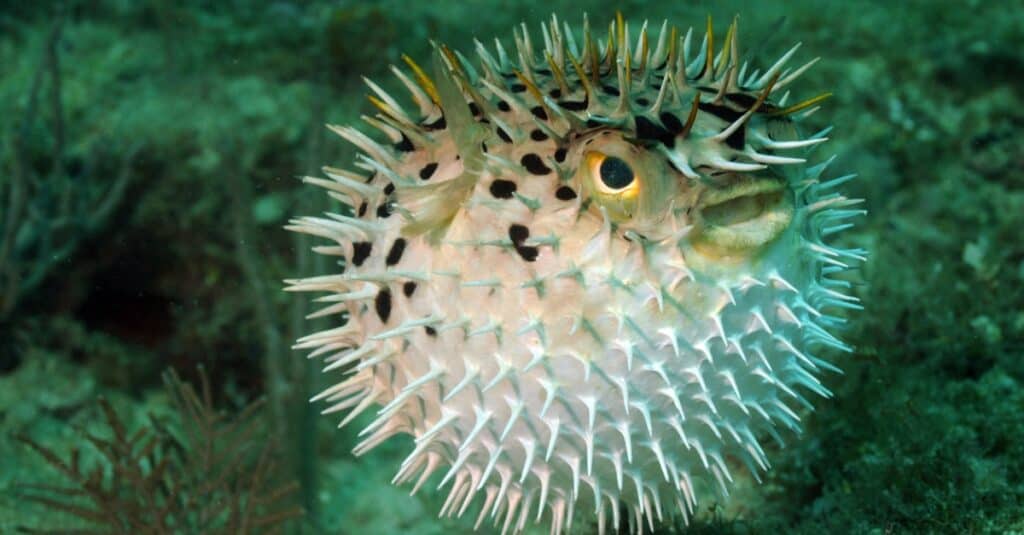Animals come in various sizes and shapes, but only a handful can alter their shapes. However, Ecuadorian researchers just found a new frog species capable of changing its skin texture to smooth (from its typical spiny texture). That is the first-ever vertebrate reported to have shape-shifted.
Most animals will either hide or run when faced with a predator attack. Sometimes, running might expose them more to their predators. But an animal that resembles its environment can survive by camouflaging itself from predators, such as moths resembling fallen tree leaves. Unfortunately, the animal may also use the same tactics to attract its prey.
Many animals have adapted permanently to mimic their environments. But other than the mutable rain frog, only a handful of other animals can change their shape.
Today, we discover five animals that can shape-shift to trick their predators and prey.
#1 – The Mutable Rain frog
This frog is known scientifically as Pristimantis mutabilis and is sometimes called rain frog, punk rock, or mutable rain frog. It is found in Ecuador’s Imbabura and Pichincha provinces, particularly in the Ecuadoran Andes.
A male mutable rain frog measures about 0.67 inches, and a female between 0.83 and 0.91 inches.
Males have a pale grayish green to light brown dorsum, dark brown to gray chevrons, and bright green marks. They have orange dorsolateral folds and are outlined by thin white or cream lines. Their belly is brown to pale gray with a few white spots and dark, diffuse spots. Female frogs have a red flash color.
The mutable rain frog was discovered in 2006 in the Ecuadorian rainforest. But it was only recently reported since finding a second specimen took several years. A second specimen was necessary for the frog’s shape-shifting ability to be apparent.
It takes a few seconds for the mutable rain frog to change its skin. It completely changes its texture from normal spiny skin to a smooth one in minutes.
The change happened so rapidly that when the researcher captured the amphibian to take photographs, the spines completely disappeared. So she added mosses to the container that had the frog until they could take the amphibian back to the wild. But upon checking on it later, she realized the frog’s texture was spiny again—it had changed it.
The researchers also identified the Sobetes robber frog, a second species that can shape-shift. This points to the phenomenon that many amphibian species may be capable of shape-shifting only that they are never recorded as it happens so rapidly.
The mutable rain frog is the recorded vertebrate to shift its shape over a short time.
#2 – The Golden Tortoise Beetle

Golden tortoise beetles are linked to sweet potato plants and other related species like bindweed and morning glory.
©Chui Wui Jing/Shutterstock.com
There is little biological information on the golden tortoise beetle, perhaps reflecting its little economic importance.
In America’s northern states, just one generation of the beetle appears each year. In New Jersey, they first appear in May and sometimes June and feed on weeds while depositing eggs. A new adult population emerges in July and feeds briefly before they enter diapause until the next spring. It takes about 40 days for a golden tortoise beetle to develop from egg to adult.
Golden tortoise beetles are linked to sweet potato plants and other related species like bindweed and morning glory. Both the insect’s adults and larvae feed on foliage. The insect typically creates numerous small and medium-sized irregular holes in the plants’ leaves.
Although both adults and larvae inhabit the lower surface of a leaf, they eat entirely through the foliage. But these insects are not usually considered damaging to the plants they inhabit.
Wasp parasitoid Burks and fly parasitoid Aldrich have been found to attack golden tortoise beetles. Also known to kill their larvae are:
- Several ladybird beetle predators
- Assassin bugs
- Shield bugs
- Damsel bugs.
The golden tortoise beetle’s larva carries a shield to protect itself from small predators. But it does not seem to deter large predators, particularly those endowed with long and piercing-sucking mouthparts.
The golden tortoise beetle can change its color to blend with its environments and avoid predation or when mating. It employs the same mechanism used by chameleons and other specialist color changers.
But there is more.
It is also capable of changing its color finish. For example, it can change its color from shiny gold to dull red.
So, how does the golden tortoise beetle achieve this?
The golden tortoise beetle creates an optical illusion. The tiny grooves in its shell form a shiny surface full of liquid. The surface turns dull again when the liquid is drained.
The beetle also metamorphoses from a larva to an adult, the same way a caterpillar morphs into a butterfly.
The metamorphosis occurs when cells grow and specialize as the beetle matures. It occurs as a result of hormonal changes.
#3 – Cuttlefish

Cuttles have eight arms, large W-shaped pupils, and two tentacles. The tentacles have denticulated suckers that help them secure prey.
Cuttlefish, or simply cuttles, are marine mollusks in the class Cephalopoda, alongside nautiluses, octopuses, and squids. They have a unique internal shell known as the cuttlebone that they use to control buoyancy.
Cuttles have eight arms, large W-shaped pupils, and two tentacles. The tentacles have denticulated suckers that help them secure prey.
Cuttlefish’s sizes generally range between six and ten inches. But the species, known as the giant cuttlefish, can reach 20 inches in mantle length and over 23 pounds in mass.
Cuttlefish eat smaller cuttlefish, worms, octopuses, fish, shrimp, crabs, and mollusks. Their predators include other cuttlefish, seabirds, seals, sharks, and dolphins.
Cuttlefish have a life expectancy of about one to two years.
Cuttlefish are some of the most intelligent invertebrates. Their brain-to-body size ratio is also one of the largest of all invertebrates.
Cuttlefish can mimic their environment by changing their skin’s texture, pattern, and color. To achieve this, they alter their skin pigments to change how it reflects light. The neurons in the fish’s brain control this process by transmitting impulses and information to the fish’s entire body.
In addition to camouflaging, cuttlefish are capable of altering their skin with the aim of startling predators or communicating with fellow cuttlefish.
Interestingly, cuttles have also been christened cross-dressers as males can imitate females to enable them to sneak past fellow males in their quest to mate with females.
#4 – The Mimic Octopus

The mimic octopus prefers estuaries and river mouths and not reefs, which are a preferred habitat by other octopus types.
©DiveIvanov/Shutterstock.com
It is an octopus species found in the Indo-Pacific region. Like other octopuses, the mimic octopus disguises itself with its environment using chromatophores.
The octopus feeds on:
- Worms
- Crabs
- Small fish.
The mimic octopus prefers estuaries and river mouths and not reefs, which are a preferred habitat by other octopus types. This is attributable to its ability to imitate dangerous animals, which puts it at less risk of being preyed upon.
The mimic octopus is classified as either a forager or a hunter. It is a hunter because it can hunt down and catch small fish. But, more often, the octopus forages for food. They are carnivores and do not eat any vegetation or plant.
The mimic octopus was discovered off an Indonesian island’s coast in 1998. It is perhaps the greatest of all shape-shifters. Like the cuttlefish, it can mimic its environment by changing its skin’s texture and color.
Impressively, the mimic octopus can mimic various species in its surroundings. Over 13 species have so far been confirmed, including:
- Sea anemones
- Jellyfish
- Sea snakes
- Lionfish
- Mantle
- Zebra sole
Most species that the mimic octopus mimics are poisonous, giving it protection from predators. It has also been reported to mimic female or male crabs to lure them before feeding on them.
With its remarkable agility, the mimic octopus can change its texture, shape, behavior, and color. It is also capable of altering its mimicry as per the circumstances.
The mimic octopus can camouflage with its typically sandy environment. It has been observed to imitate sessile animals like colonial tunicates, tube-worm tubes, and small sponges.
The octopus intelligently uses its mimicry depending on the situation it is trying to handle. For instance, when a damselfish harasses it, it may mimic the banded sea snake, a damselfish’s predator. The octopus decides the most appropriate mimicry behavior based on the situation and environment and acts upon it.
#5 – Pufferfish

Pufferfish have a unique defense mechanism compensating for their slow movement.
©J.T. Lewis/Shutterstock.com
The pufferfish belongs to the Tetraodontidae family. The fish are also known as:
- Sea squab
- Sugar toads
- Honey toads
- Toadle
- Toadies toadfish
- Swellfish
- Globefish
- Blowies
- Blowfish
- Balloonfish
- Puffers
A pufferfish is morphologically similar to its close cousin, the porcupine fish, which has large external spines.
Pufferfish and porcupine fish can puff themselves up when they feel threatened. The fish inflate their stomachs with air or water to make themselves unattractive to predators. They can grow to more than double their normal size, making them too large for predators with smaller mouths.
Additionally, most pufferfish and porcupine fish have deadly toxins–much more poisonous than cyanide. Predators who take the toxins do not last long.
But pufferfish are a delicacy in some countries such as Japan, where trained chefs carefully cook them. Unfortunately, even with trained chefs cooking them, several people still die every year from eating pufferfish.
The pufferfish diet varies depending on its environment. Traditionally, it feeds primarily on small invertebrates and algae. Although it can survive vegetation if its environment lacks resources, it prefers an omnivorous diet.
Larger pufferfish species can use their front teeth to rip open other shellfish, mussels, and clams. Some pufferfish species employ different hunting techniques, including open-water hunting and ambush.

The stomach of a pufferfish can inflate up to three times its normal size.
©iStock.com/FtLaudGirl
Pufferfish have a unique defense mechanism compensating for their slow movement. They move by combining caudal, anal, dorsal, and pectoral fin motions, making them highly maneuverable but slow, hence easy targets for predators.
Their tail fins act as a rudder but can also be used when they need to evade danger fast. Combined with their excellent eyesight, the speed burst is the puffer’s first and vital defense against its predators.
The puffer’s second defense mechanism is filling its highly elastic belly with air or water until it is larger and nearly spherical.
Although invisible when not inflated, a pufferfish has pointed spines, making it an unpleasant, pointy ball instead of a slow, easy prey. Any predators who do not heed the puffer’s warning may get choked, while those who succeed in swallowing the pufferfish will fill their bellies with tetrodotoxin. This makes pufferfish an unpleasant and lethal prey choice.
Key Take-Aways
The organisms listed above could just be the tip of the iceberg, and many shape-shifting organisms are yet to be discovered. The ability to shape-shift has long been restricted to science fiction books and big-screen horror monsters. Not anymore. Although most people might never get to meet organisms that can radically change their shapes in real life, evolution has brought with it organisms with this ability. They may create a change illusion, contort their shape, or even appear to grow in size.
Up Next…
- 10 Camouflaged Snakes That You’ll Never See Coming!
- Can You Find the Camouflaged Mountain Lion in This Viral Photo?
- Can You Spot This Camouflaged Copperhead Snake Hiding in Plain Sight?
The photo featured at the top of this post is © DiveIvanov/Shutterstock.com
Sources
- Wiley, Available here: http://onlinelibrary.wiley.com/doi/10.1111/zoj.12222/abstract
- Arkive, Available here: http://www.arkive.org/sobetes-robber-frog/pristimantis-sobetes/
- ICR, Available here: https://www.icr.org/article/smart-stealthy-cuttlefish
Thank you for reading! Have some feedback for us? Contact the AZ Animals editorial team.






